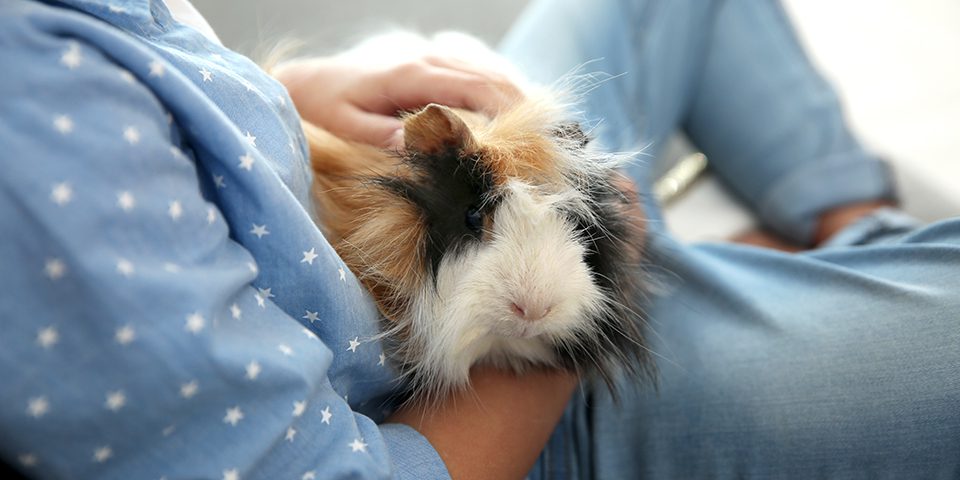By Kellie Hayden
Updated: Aug 14, 2024
While the thought of restraining a beloved pet can make any caring pet parent a little uncomfortable, knowing how to properly hold and secure your animal is an essential part of pet parenthood. Proper holds prevent your pet, yourself, and others from serious injuries like broken bones. Proper restraint can also help greatly in limiting you and your pet’s stress while administering medication or Critical Care if they’re feeling unwell.
General guidelines for safely holding small mammals include:
- Get your pet used to hands first.
- Be secure, but don’t squeeze.
- Keep pets close to your body (facing away from you) for additional support.
- For families, adult supervision is key.
- Avoid heights unless necessary.
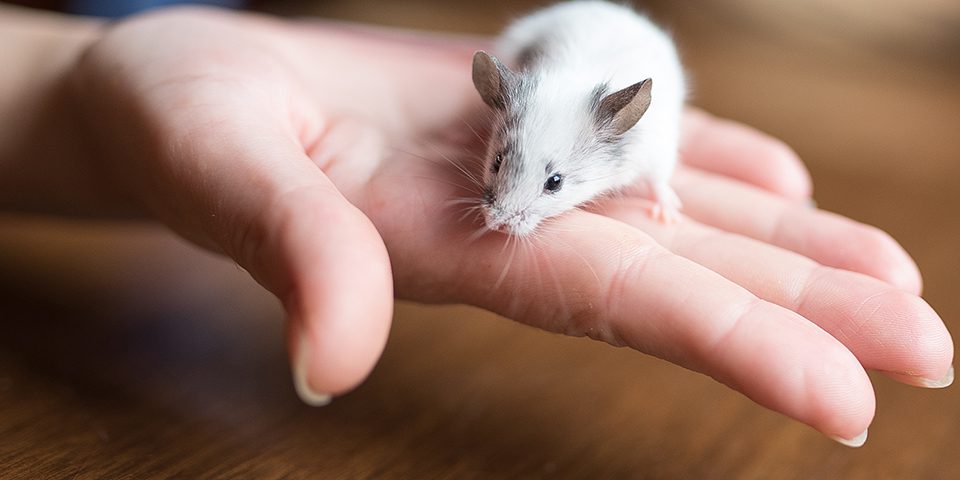
Getting your Small Pet Accustomed to Hands
Before you attempt to restrain your pet, it will be especially helpful to get your pet used to hands first. The sooner you accustom your pet to hands, the better off you will be; so many aspects of pet care involve handling your small pet, so using fear-free training techniques can strengthen the trusting bond you have with your pet.
During this part of the process, show your pet that affection through pets and “scritches” are safe. Get them accustomed to affection being a positive interaction, and offer them healthy foods during this process. Allowing your pet to safely interact with your hand, such as stepping onto it for a healthy treat as a trick, can be a great way to build trust as well. By getting an animal used to your hands first, the process of being picked up and restrained will become less of a scary ordeal for your small pet.
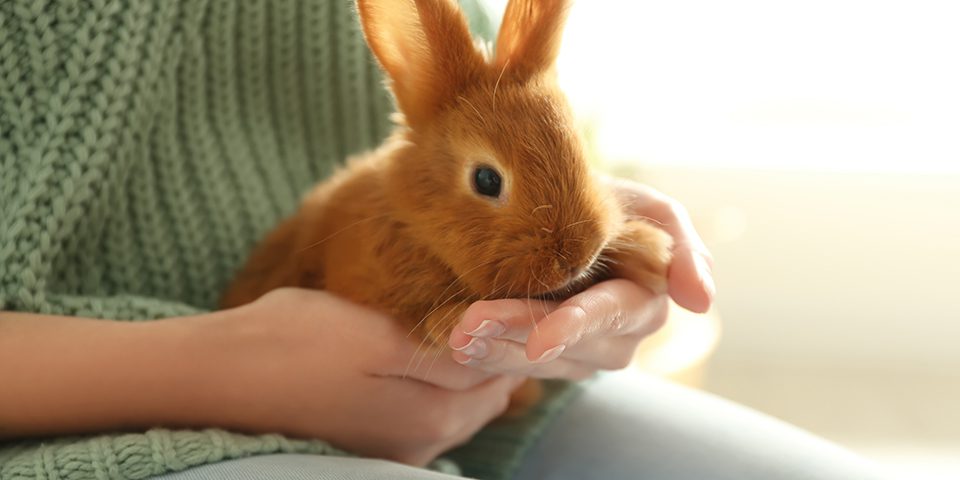
Learning to Hold Your Pet Securely
Securely holding an animal so they cannot wiggle out of your hands is of utmost importance to their safety, but making sure you’re not holding too tightly is just as important. If you’re new to holding your pet’s species, start by simply holding your pet an inch off of the ground so the risk of an injury from a fall is unlikely. From here, you can adjust your grip to be just right so that they are neither at risk of being squeezed nor at risk of freeing themselves and causing an injury. It will take time and practice, but you’ll get a feel for it. Keep practicing and make sure to offer species-appropriate treats as a reward for all this practice (remember, your pet is also practicing and adjusting their behavior during this process!).
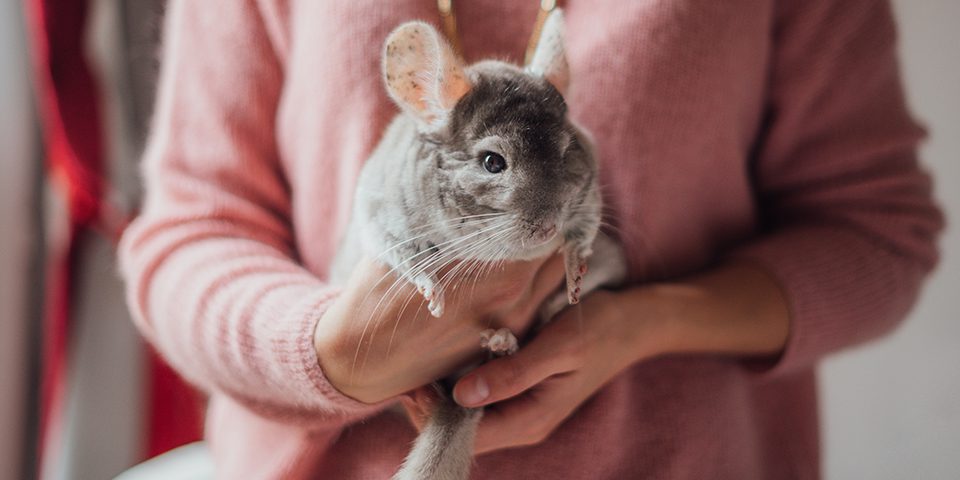
A Technique for Additional Support
When you’ve mastered handling close to the ground, you can then begin practicing holding your pet’s body close to yours for additional support.
Face the animal away from you so their back is facing you, especially if you are not familiar with the animal. It’s relatively rare for small mammals to bite out of anxiety or fear, but it’s best to not open yourself up to the possibility of a bite to your torso. This is especially the case if you’re in the beginning stages of developing a trusting, loving bond with a new pet.
As you become more comfortable with the animal and learn what their particular behaviors are when they’re picked up, you can have the animal face you.
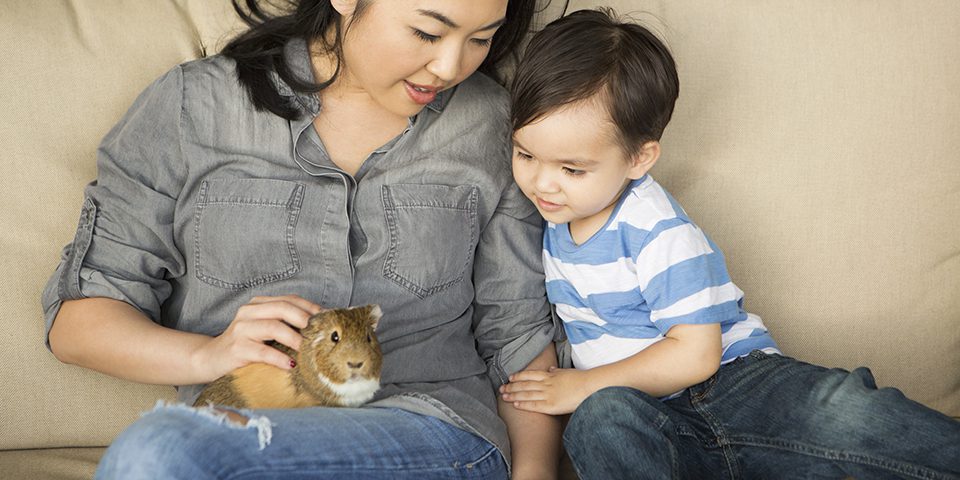
Supervise Interactions Between Pets and Children
Just like with cats and dogs, we do not recommend that children–especially young children–handle any small animal on their own. Older children who are helping provide care for the pet (such as weekly enclosure cleanings) are good candidates for learning how to securely hold small pets, but we do not recommend that young children hold animals. As an alternative, interactions can take place on the ground with an animal being placed into the child’s lap inside a play pen. Small animals generally do not enjoy being snuggled until they have built a trusting bond with their family, so the animal should have opportunity to navigate freely within the play pen and not be forced to sit in one place.
When a child is ready to learn how to handle an animal, adults should repeatedly explain the importance of holding an animal properly, then supervise while children learn to hold animals only an inch off the ground as described above.
Avoid Unnecessary High Lifting
Don’t lift the animal high from the ground unless necessary. Accidents can and do happen, and falls from high places may cause serious, painful injuries for even the most acrobatic species.
Improper Holds
Generally speaking, it is not recommended or necessary to “scruff” any small animal species we discuss in this blog post. It is also never acceptable to pick up an animal by a leg, tail, or their ears. These handling methods are often harmful and can lead to injuries due to lack of proper restraint. Improper holds also significantly increases the amount of stress an animal experiences, which can lead to small animals becoming less trusting of humans over time.
Two hands should always be used when holding a small exotic animal to keep them properly secured.
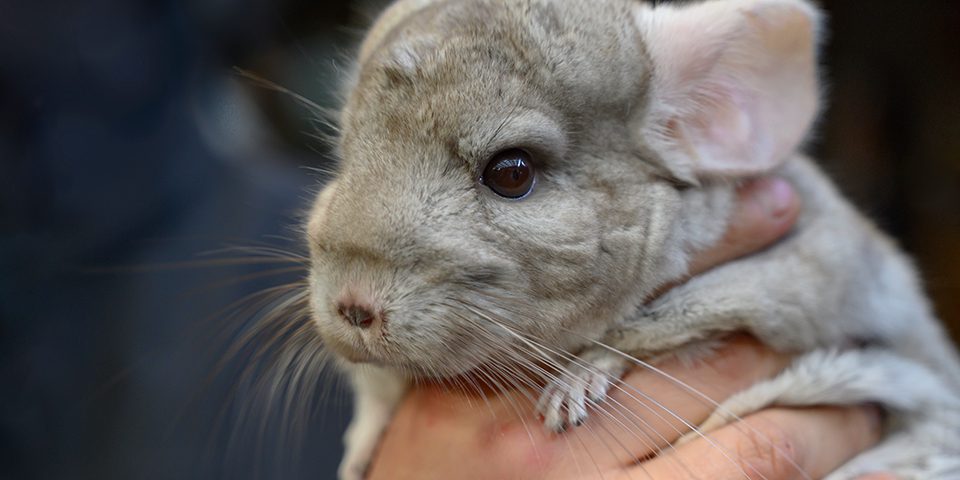
How to Hold Herbivores: Chinchillas, Rabbits, and Guinea Pigs
While not identical, the holds for rabbits, guinea pigs, and chinchillas share similarities. If you have an animal that is frightened, prone to bolting, or is very squirmy, locking one of their front legs between your fingers can be especially helpful in securing them. This, paired with holding them close to your body, will limit how much the animal struggles and can help keep them calm.
This pet parent in the chinchilla photo above has fingers placed above and below one of the pet’s front legs. The top finger and palm support the chest, while the thumb sits underneath the animal’s other front leg. They are supporting the animals’ behind (and therefore body weight) with their other hand.
When using this hold, it is vitally important to remember that the hand restraining your pet’s front end should not be supporting your pet’s weight or squeezing the animal. Small mammals have delicate ribs and need their weight supported on the back half of their body to avoid injuries to the ribcage.
A Note on Chinchillas, Rabbits, and Wiggly Guinea Pigs
If your pet has powerful legs (such as rabbits or chinchillas), or if an individual guinea pig is quite wiggly and tries to leap out of your hands, hold their backside only while not supporting their back legs to prevent any kicking behaviors from launching your pet out of your hands.
For chinchillas, another option is to securely hold the base of their tail (not towards the middle or tip of the tail) while supporting their backside. While we don’t ever recommend picking up an animal by their tail, securing a chinchilla in this way while holding them can help as an “insurance policy” in case a chinchilla does happen to wiggle out of the hand securing the front end of their body.

Notice how this rabbit looks uncertain—they might be in a new environment, or meeting someone new. The pet parent is holding the animal close to their body, with one hand underneath both of the front legs. The right hand is available to support the animal’s backside when the pet parent stands up with the rabbit, but for now, the rabbit’s feet are being supported on her lap. Sitting on the ground in this way during interactions is a good method to help keep an animal more comfortable, rather than standing up with the animal high off of the ground.
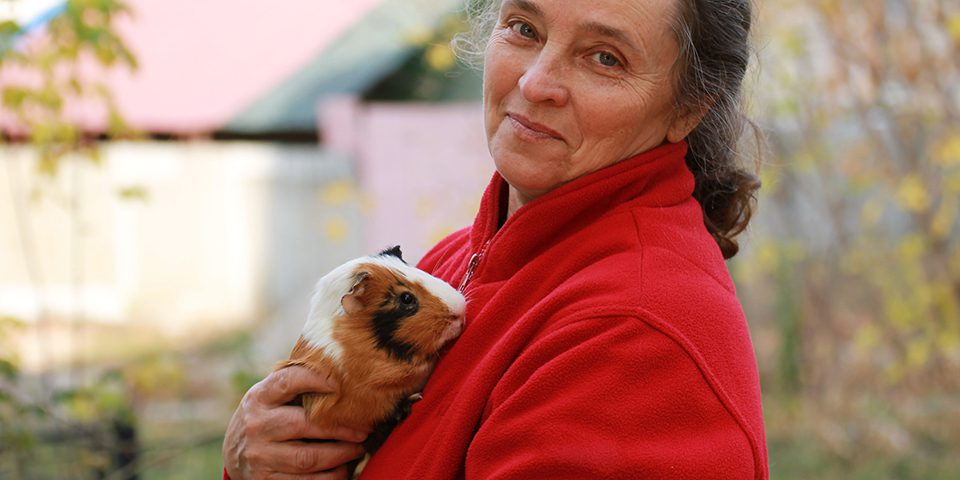
This pet parent is holding the animal facing them, but the animal is still secured with one hand behind their back. The other hand is used to support the animal’s backside. Facing an animal toward you in this way should be done only when you have built a lot of mutual trust together, as this method opens you up to potential bites if an animal is especially stressed or is in pain.
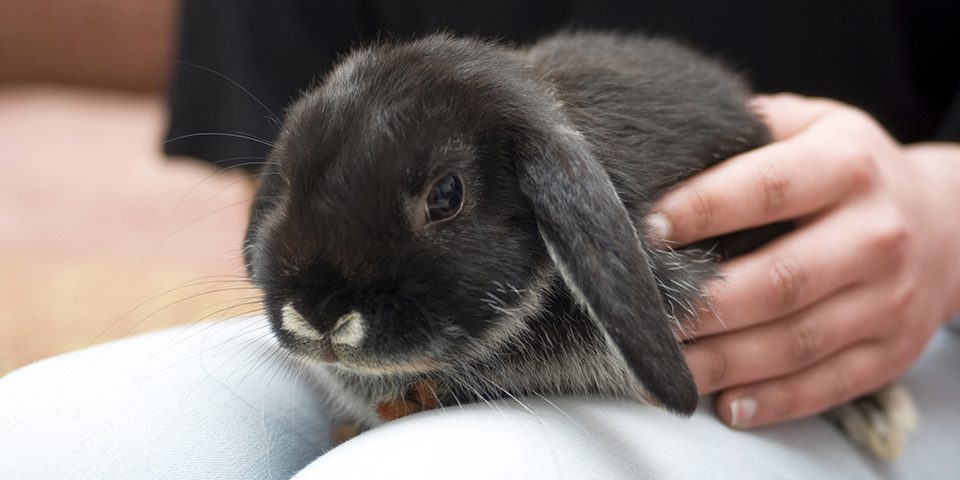
Lap Time with Small Herbivores
Secure lap time can be a good option to strengthen the bond between you and your rabbit, guinea pig, or chinchilla. When it’s snuggle time, you can place your pet on your lap to allow them to feel less restrained. These pet parents pictured above have their pet resting on their lap, and have at least one hand on their pet to quickly secure the animal if necessary. Being able to secure an animal quickly is vitally important when prey species are sitting on an examination table or surface with a ledge (such as a couch during snuggle time), as they may startle easily due to unexpected noises. Your free hand can also be used to mediate interactions between your pet and other people in the room.
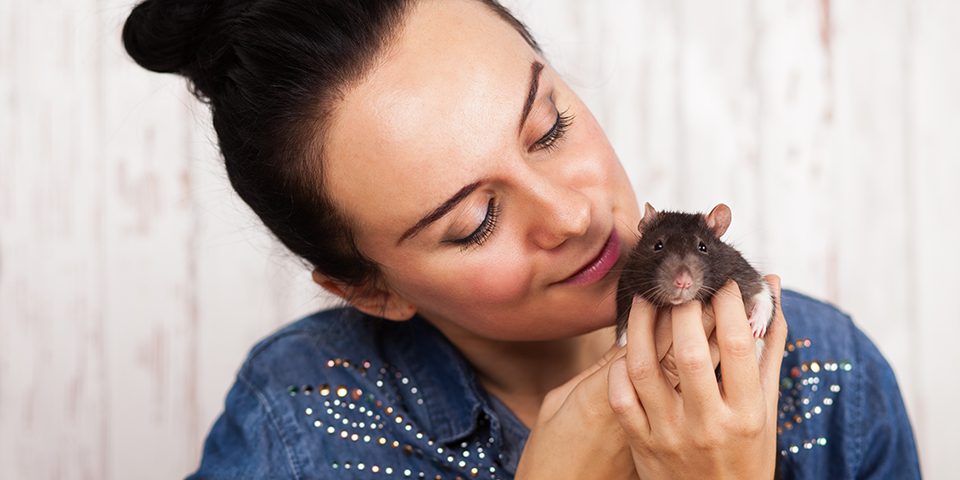
How to Hold Omnivores: Rats, Mice, and Hamsters
While rats, mice, and hamsters are more agile than the herbivorous species covered here, they still need adequate support and restraint while being held, especially if they are in new or potentially stressful situations.
When it comes to small omnivores, if you’re unfamiliar with an individual animal’s habits (such as when you’re welcoming a new pet home), do not handle them with an open, outstretched palm high off the ground. This can easily lead to injuries if they fall from your hand, and also opens you up to unexpected nibbles or bites.
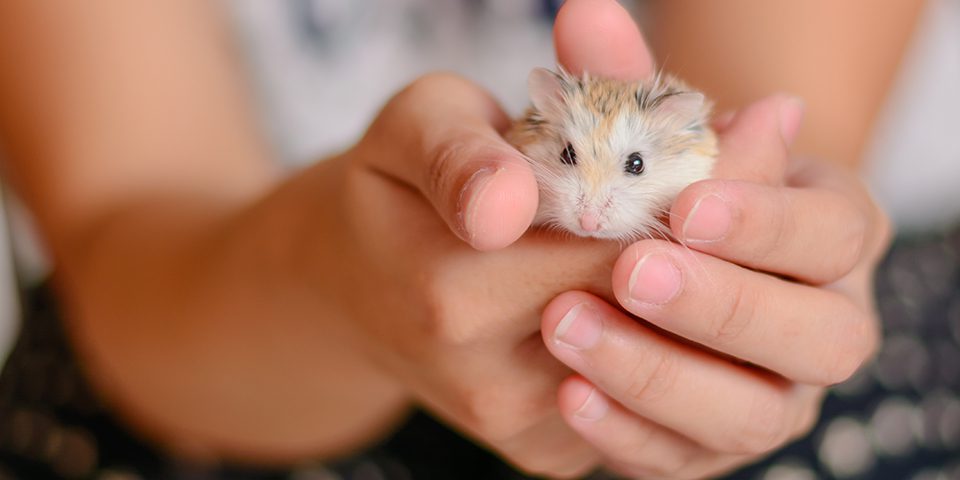
New pet parents should start by handling their rat, hamster, or gerbil with both hands. One hand should support the belly and backside of your pet, while the other hand secures the pet in place.
Once your pet has become more accustomed to their surroundings, they can enjoy lap time. First start with a calm, quiet setting, and keep at least one hand on your pet as a reminder to them that they are safe and secure. Eventually, your pet will become more confident—at this point, you can allow them to climb and explore while supervised.
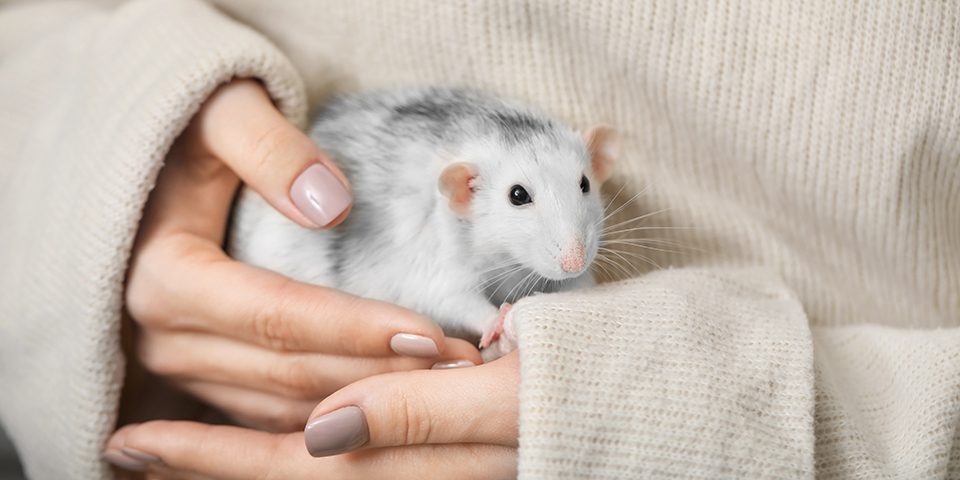
This rat is given more freedom to move around without restraint, but the pet parent is still holding them with both hands.
Respect Your Pet’s Autonomy
It can be difficult for some pet parents to accept that small exotics may not be as snuggly as cats or dogs. Keep in mind that many small animals are prey species and have the hard-wired instincts of an animal that, in the wild, could be a potential meal for a predator at any moment. Because of this, it’s important to learn your pet’s cues for when they are not interested in being handled.
If at any point when you’re working on learning how to hold your pet and you notice your animal seems to be “done” with the training session, don’t force it. Just like people, some pets don’t like physical touch while others don’t mind it. Capping training sessions at a couple of minutes per session can go a long way towards building a trusting bond with your small pet while also ensuring that you can properly handle and restrain your pet in emergency situations.
Don’t Get Discouraged!
Learning how to hold small mammals takes time. Your pet may not enjoy being picked up and held right now, but with continuous practice and plenty of treats, picking up and handling your pet will become a low-stress process for you both.

